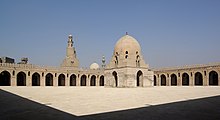Mosque of Ibn Tulun
| Ibn Tulun Mosque | |
|---|---|
 |
|
| Basic information | |
| Location | Cairo, Egypt |
| Affiliation | Islam |
| Year consecrated | 884 |
| Ecclesiastical or organizational status | Mosque |
| Leadership | Ahmed ibn Tulun |
| Architectural description | |
| Architectural type | Mosque |
| Architectural style | Abbasid |
| Completed | 879 |
| Specifications | |
| Dome(s) | 2 |
| Minaret(s) | 1 |
| Materials | brick |
The Mosque of Ahmad Ibn Ţūlūn (Arabic: مسجد أحمد بن طولون) is located in Cairo, Egypt. It is arguably the oldest mosque in the city surviving in its original form, and is the largest mosque in Cairo in terms of land area.
The mosque was commissioned by Ahmad ibn Ţūlūn, the Turkic Abbassid governor of Egypt from 868–884 whose rule was characterized by de facto independence. The historian al-Maqrizi lists the mosque's construction start date as 876 AD, and the mosque's original inscription slab identifies the date of completion as 265 AH, or 879 AD.
The mosque was constructed on a small hill called Gebel Yashkur, "The Hill of Thanksgiving." One local legend says that it is here that Noah's Ark came to rest after the Deluge, instead of at Mount Ararat.
The grand ceremonial mosque was intended as the focal point of Ibn Ţūlūn's capital, al-Qata'i, which served as the center of administration for the Tulunid dynasty. The mosque originally was backed by ibn Ţūlūn's palace, and a door adjacent to the minbar allowed him direct entry to the mosque. Al-Qata'i was razed in the early 10th century, AD, and the mosque is the only surviving structure. The mosque was constructed in the Samarran style common with Abbasid constructions. The mosque is constructed around a courtyard, with one covered hall on each of the four sides, the largest being on the side of the qibla, or direction to Mecca. The original mosque had its ablution fountain (sabil) in the area between the inner and outer walls. A distinctive sabil with a high drum dome was added in the central courtyard at the end of the thirteenth century by the Sultan Lajīn.
...
Wikipedia
